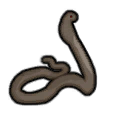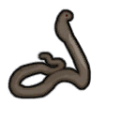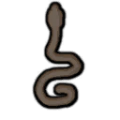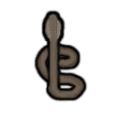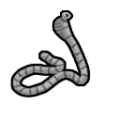Cobra
Cobra
A large predatory snake. Cobras can be highly aggressive if provoked, and their bite injects toxic venom into the victim.
Base Stats
- Type
- Animal
- Flammability
- 70%
Pawn Stats
- Move Speed
- 3.5 c/s
- Health Scale
- 50% HP
- Body Size
- 0.25
- Mass - Baby
- 3 kg
- Mass - Juvenile
- 7.5 kg
- Mass - Adult
- 15 kg
- Carrying Capacity
- 19
- Filth Rate
- 1
- Hunger Rate
- 0.11 Nutrition/Day
- Diet
- carnivorous and ovivorous
- Life Expectancy
- 20 years
- Manhunter Chance
- 50%
- Manhunter Chance (Taming)
- 10%
- Trainable Intelligence
- None
- Wildness
- 75%
- Minimum Handling Skill
- 7
- Mate Interval
- 12 hours
- Maturity Age
- 0.5 years (30 days)
- Juvenile Age
- 0.15 years (9 days)
- Comfortable Temp Range
- 0 °C – 60 °C (32 °F – 140 °F)
Production
- Meat Yield
 36 cobra meat
36 cobra meat- Leather Yield
 18 lizardskin
18 lizardskin- Eggs Per Clutch
- 1 to 2
- Egg Laying Interval
- 10 days
- Can Lay Unfertilized Eggs
- false
Melee Combat
- Attack 1
- Mouth
12 dmg (Toxic bite)
18 % AP
2 second cooldown
Stun for 280 ticks (4.67 secs) on first strike - Attack 2
- Head
3 dmg (Blunt)
4 % AP
2 second cooldown
0.2 chance factor - Average DPS
- 3.72
Cobras are predatory and ovivorous snakes found only in tropical rainforests and tropical swamps. They eat smaller animals, and sometimes people if they don't find a smaller prey in time.
Their bite causes toxic buildup.[How much?] The toxic buildup from their bite is not applied when they are hunting, to prevent rotting their would-be prey and leaving them unable to eat it.
Analysis
In a tropical biome, cobras are a persistent threat to your small animals, children,![]() and possibly unarmed adults. When fighting a single cobra, its toxic bite is unlikely to make a difference, at least with adult colonists. However, the toxins can add up when fighting a manhunter pack of cobras. It can also matter when a cobra fights smaller targets.
and possibly unarmed adults. When fighting a single cobra, its toxic bite is unlikely to make a difference, at least with adult colonists. However, the toxins can add up when fighting a manhunter pack of cobras. It can also matter when a cobra fights smaller targets.
There's not much reason to tame a cobra, or keep a tamed cobra. Cobras cannot be trained to attack, and even if you use allowed areas to force a cobra to fight, it is one of the weakest predators in the game. In the tropics, you have access to elephants. Elephants are one of the strongest animals in the game, can be trained to attack, can graze on grass, and are just as easy to tame. In addition, elephants will not go manhunter on a failed taming attempt. For meat, tortoises are strictly better.
Training
This animal can be trained as follows:
| Guard: | |
|---|---|
| Attack: | |
| Rescue: | |
| Haul: | |
*As of version 1.1.2610, all animals can be tamed. The percentage of likelihood of success depends on factors such as the Animals Wildness Percentage, Pawn Handling Skill, and others. More information can be found on the animals page.
Health
Trivia
Unlike in real life and most animals in RimWorld, cobras have no skeletons besides their skull.
Gallery
Version history
- 0.7.581 - Added
- 0.12.906 - Can now lay eggs
- 0.18/1.0 - Now provides the new lizardskin, which merged its previous leather type, cobraskin, with tortoise leather and iguana skin.
- ? - Cobras no longer use their venom when hunting. Previously, cobras had a tendency to inadvertently destroy entire ecosystems when hungry. Predators hunt when hungry, but the cobra's bite inflicted toxic buildup which caused the prey's corpse to rot. This prevented the cobra from being able to eat the corpse, which left them hungry, so they'd go hunting again and the cycle repeated. Eventually they'd leave a string of rotting animals corpses and still end up malnourished.
